
24LLC16
16K-Bit-Serial EEPROM
* All specs and applications shown above subject to change without prior notice.
1F-5 NO.66 SEC.2 NAN-KAN RD ., LUCHU , TAOYUAN, TAIWAN
Email: server@ceramate.com.tw
Tel:886-3-3214525 Http: www.ceramate.com.tw
Fax:886-3-3521052
Page
1 of 22
Rev 1.0 Aug.5, 2002
OVERVIEW
The 24LLC16 serial EEPROM has a 16 Kbits (2,048 bytes) capacity, supporting the standard I
2
CTM-bus serial
interface. It is fabricated using CERAMATE's most advanced CMOS technology. One of its major features is a
hardware-based write protection circuit for the entire memory area. Hardware-based write protection is controlled
by the state of the write-protect (WP) pin. Using one-page write mode, you can load up to 16 bytes of data into
the EEPROM in a single write operation. Another significant feature of the 24LLC1616 is its support for fast
mode and standard mode.
FEATURES
I
2
C-Bus Interface
�
Two-wire serial interface
�
Automatic word address increment
EEPROM
�
16 Kbits (2,048 bytes) storage area
�
16-byte page buffer
�
Typical 3 ms write cycle time with
auto-erase function
�
Hardware-based write protection for the entire
EEPROM (using the WP pin)
�
EEPROM programming voltage generated
on chip
�
1,000,000 erase/write cycles
�
100 years data retention
Operating Characteristics
�
Operating voltage: 2.0 V to 5.5 V
�
Operating current
-- Maximum write current: < 3 mA at 5.5 V
-- Maximum read current: < 200
�
A at 5.5 V
-- Maximum stand-by current: < 2
�
A at 2.0 V
�
Operating temperature range
-- � 25�C to + 70�C (commercial)
-- � 40�C to + 85�C (industrial)
�
Operating clock frequencies
-- 100 kHz at standard mode
-- 400 kHz at fast mode
�
Electrostatic discharge (ESD)
-- 5,000 V (HBM)
-- 400 V (MM)
Packages
�
8-pin DIP, SOP, and TSSOP
ORDERING INFORMATION
24 LLC 16 X X
Operating Voltage Type Temp. grade Packing
LLC:2.0~5.5V,CMOS 16=16K Blank:-25
~+70
Blank :Tube
A :Taping(SOP8)
T :Taping(TSSOP8)

24LLC16
16K-Bit-Serial EEPROM
* All specs and applications shown above subject to change without prior notice.
1F-5 NO.66 SEC.2 NAN-KAN RD ., LUCHU , TAOYUAN, TAIWAN
Email: server@ceramate.com.tw
Tel:886-3-3214525 Http: www.ceramate.com.tw
Fax:886-3-3521052
Page
2 of 22
Rev 1.0 Aug.5, 2002
Start/Stop
Logic
Slave Address
Comparator
Word Address
Pointer
Row
decoder
EEPROM
Cell Array
2,048 x 8 bits
HV Generation
Timing Control
Control Logic
Column Decoder
Data Register
D
OUT
and ACK
SCL
WP
SDA
A0
A1
A2
Figure 5-1. 24LLC16 Block Diagram

24LLC16
16K-Bit-Serial EEPROM
* All specs and applications shown above subject to change without prior notice.
1F-5 NO.66 SEC.2 NAN-KAN RD ., LUCHU , TAOYUAN, TAIWAN
Email: server@ceramate.com.tw
Tel:886-3-3214525 Http: www.ceramate.com.tw
Fax:886-3-3521052
Page
3 of 22
Rev 1.0 Aug.5, 2002
24LLC16
V
CC
WP SCL SDA
A0 A1 A2 V
SS
NOTE:
The 24LLC16 is available in
8-pin DIP, SOP, and TSSOP package.
Figure 5-2. Pin Assignment Diagram
Table 5-1. 24LLC16 Pin Descriptions
Name Type Description Circuit
Type
A0, A1, A2 � No internal connection �
V
SS
� Ground pin. �
SDA I/O Bi-directional data pin for the I
2
C-bus serial data interface. Schmitt
trigger input and open-drain output. An external pull-up resistor
must be connected to V
DD.
3
SCL Input Schmitt trigger input pin for serial clock input. 2
WP Input Input pin for hardware write protection control. If you tie this pin to
V
CC,
the write function is disabled to protect previously written data
in the entire memory; if you tie it to V
SS
, the write function is
enabled. This pin is internally pulled down to V
SS.
1
V
CC
� Single power supply. �
NOTE
: See the following page for diagrams of pin circuit types 1, 2, and 3.

24LLC16
16K-Bit-Serial EEPROM
* All specs and applications shown above subject to change without prior notice.
1F-5 NO.66 SEC.2 NAN-KAN RD ., LUCHU , TAOYUAN, TAIWAN
Email: server@ceramate.com.tw
Tel:886-3-3214525 Http: www.ceramate.com.tw
Fax:886-3-3521052
Page
4 of 22
Rev 1.0 Aug.5, 2002
WP
Figure 5-3. Pin Circuit Type 1
SCL
Noise
Filter
Figure 5-4. Pin Circuit Type 2
SDA
V
SS
Data Out
Noise
Filter Data In
Figure 5-5. Pin Circuit Type 3

24LLC16
16K-Bit-Serial EEPROM
* All specs and applications shown above subject to change without prior notice.
1F-5 NO.66 SEC.2 NAN-KAN RD ., LUCHU , TAOYUAN, TAIWAN
Email: server@ceramate.com.tw
Tel:886-3-3214525 Http: www.ceramate.com.tw
Fax:886-3-3521052
Page
5 of 22
Rev 1.0 Aug.5, 2002
FUNCTION DESCRIPTION
I
2
C-BUS INTERFACE
The 24LLC16 supports the I
2
C-bus serial interface data transmission protocol. The two-wire bus consists of a
serial data line (SDA) and a serial clock line (SCL). The SDA and the SCL lines must be connected to V
CC
by a
pull-up resistor that is located somewhere on the bus.
Any device that puts data onto the bus is defined as a "transmitter" and any device that gets data from the bus is
a "receiver." The bus is controlled by a master device which generates the serial clock and start/stop conditions,
controlling bus access. Only one 24LLC16 devices can be connected to the I
2
C-bus as slaves (see Figure 5-
6). Both the master and slaves can operate as a transmitter or a receiver, but the master device determines
which bus operating mode would be active.
SDA
R
V
CC
R
V
CC
SCL
24LLC16
Slave
Bus Master
(Transmitter/
Receiver)
Master
Figure 5-6. Typical Configuration
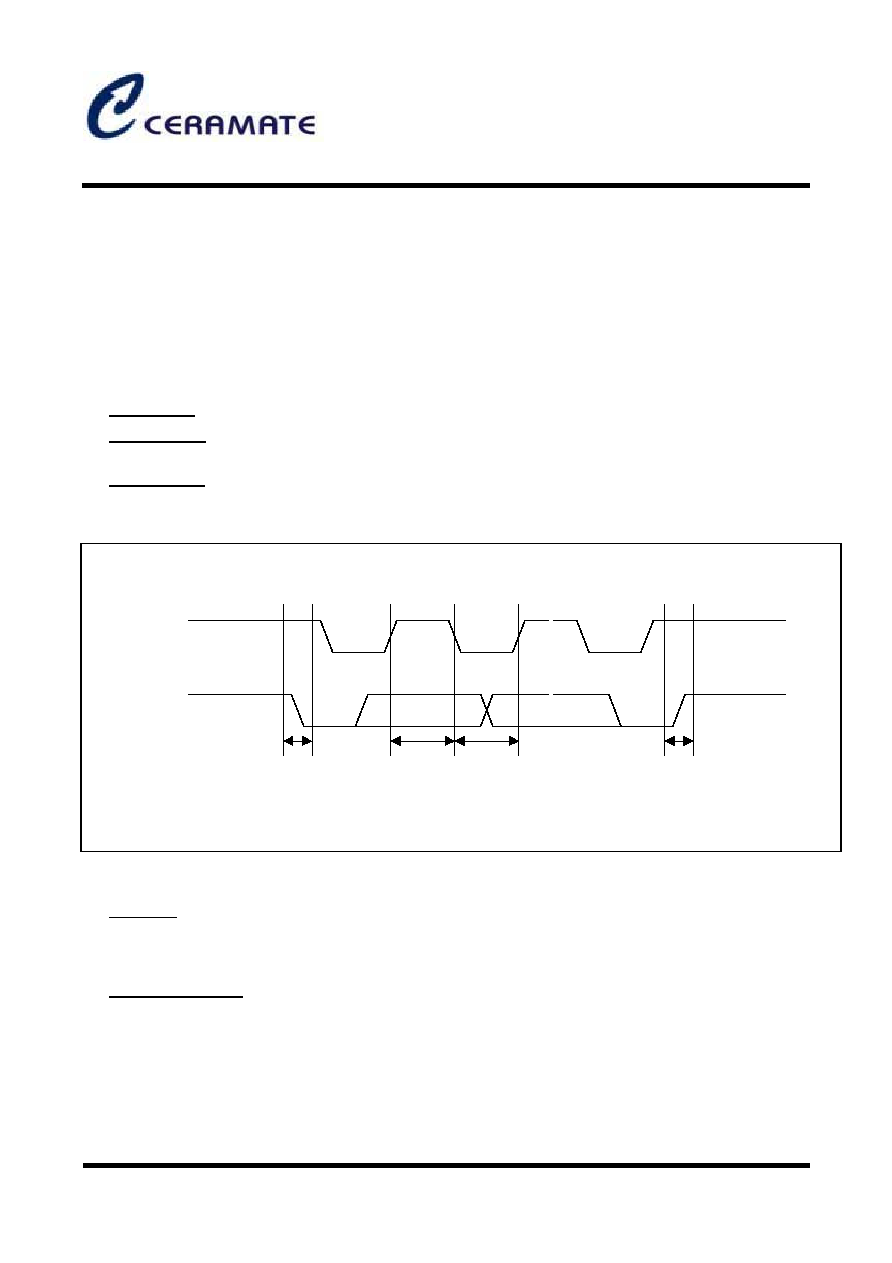
24LLC16
16K-Bit-Serial EEPROM
* All specs and applications shown above subject to change without prior notice.
1F-5 NO.66 SEC.2 NAN-KAN RD ., LUCHU , TAOYUAN, TAIWAN
Email: server@ceramate.com.tw
Tel:886-3-3214525 Http: www.ceramate.com.tw
Fax:886-3-3521052
Page
6 of 22
Rev 1.0 Aug.5, 2002
I
2
C-BUS PROTOCOLS
Here are several rules for I
2
C-bus transfers:
-- A new data transfer can be initiated only when the bus is currently not busy.
-- MSB is always transferred first in transmitting data.
-- During a data transfer, the data line (SDA) must remains stable whenever the clock line (SCL) is High.
The I
2
C-bus interface supports the following communication protocols:
�
Bus not busy: The SDA and the SCL lines remain in High level when the bus is not active.
�
Start condition: A start condition is initiated by a High-to-Low transition of the SDA line while SCL remains in
High level. All bus commands must be preceded by a start condition.
�
Stop condition: A stop condition is initiated by a Low-to-High transition of the SDA line while SCL remains in
High level. All bus operations must be completed by a stop condition (see Figure 5-7).
SCL
SDA
Start
Condition
Data or
ACK Valid
Data
Change
~
~
~
~
Stop
Condition
Figure 5-7. Data Transmission Sequence
�
Data valid: Following a start condition, the data becomes valid if the data line remains stable for the duration
of the High period of SCL. New data must be put onto the bus while SCL is Low. Bus timing is one clock
pulse per data bit. The number of data bytes to be transferred is determined by the master device. The total
number of bytes that can be transferred in one operation is theoretically unlimited.
�
ACK (Acknowledge): An ACK signal indicates that a data transfer is completed successfully. The transmitter
(the master or the slave) releases the bus after transmitting eight bits. During the 9th clock, which the master
generates, the receiver pulls the SDA line low to acknowledge that it has successfully received the eight bits
of data (see Figure 5-8). But the slave does not send an ACK if an internal write cycle is still in progress.
In data read operations, the slave releases the SDA line after transmitting 8 bits of data and then monitors
the line for an ACK signal during the 9th clock period. If an ACK is detected, the slave will continue to
transmit data. If an ACK is not detected, the slave terminates data transmission and waits for a stop condition
to be issued by the master before returning to its stand-by mode.

24LLC16
16K-Bit-Serial EEPROM
* All specs and applications shown above subject to change without prior notice.
1F-5 NO.66 SEC.2 NAN-KAN RD ., LUCHU , TAOYUAN, TAIWAN
Email: server@ceramate.com.tw
Tel:886-3-3214525 Http: www.ceramate.com.tw
Fax:886-3-3521052
Page
7 of 22
Rev 1.0 Aug.5, 2002
Master
SCL Line
Data from
Transmitter
ACK
ACK from
Receiver
Bit 9
Bit 1
Figure 5-8. Acknowledge Response From Receiver
�
Slave Address: After the master initiates a start condition, it must output the address of the device to be
accessed. The most significant four bits of the slave address are called the "device identifier." The identifier
for the 24LLC16 is "1010B". The next three bits (B2, B1, B0) are for block selection. They are used by the
master to select which of the blocks of internal memory (1 block=256 words) are to be accessed. (see Table
5-2 below.) These bits are in effect the three most significant bits of the word address
�
Read/Write: The final (eighth) bit of the slave address defines the type of operation to be performed. If the
R
/
W
bit is "1", a read operation is executed. If it is "0", a write operation is executed.
Table 5-2. Slave Address Byte
Function Device Identifier Block Select R/
W
Bit
b7 b6 b5 b4 b3 b2 b1 b0
Read 1 0 1 0 B2 B1 B0 1
Write 1 0 1 0 B2 B1 B0 0
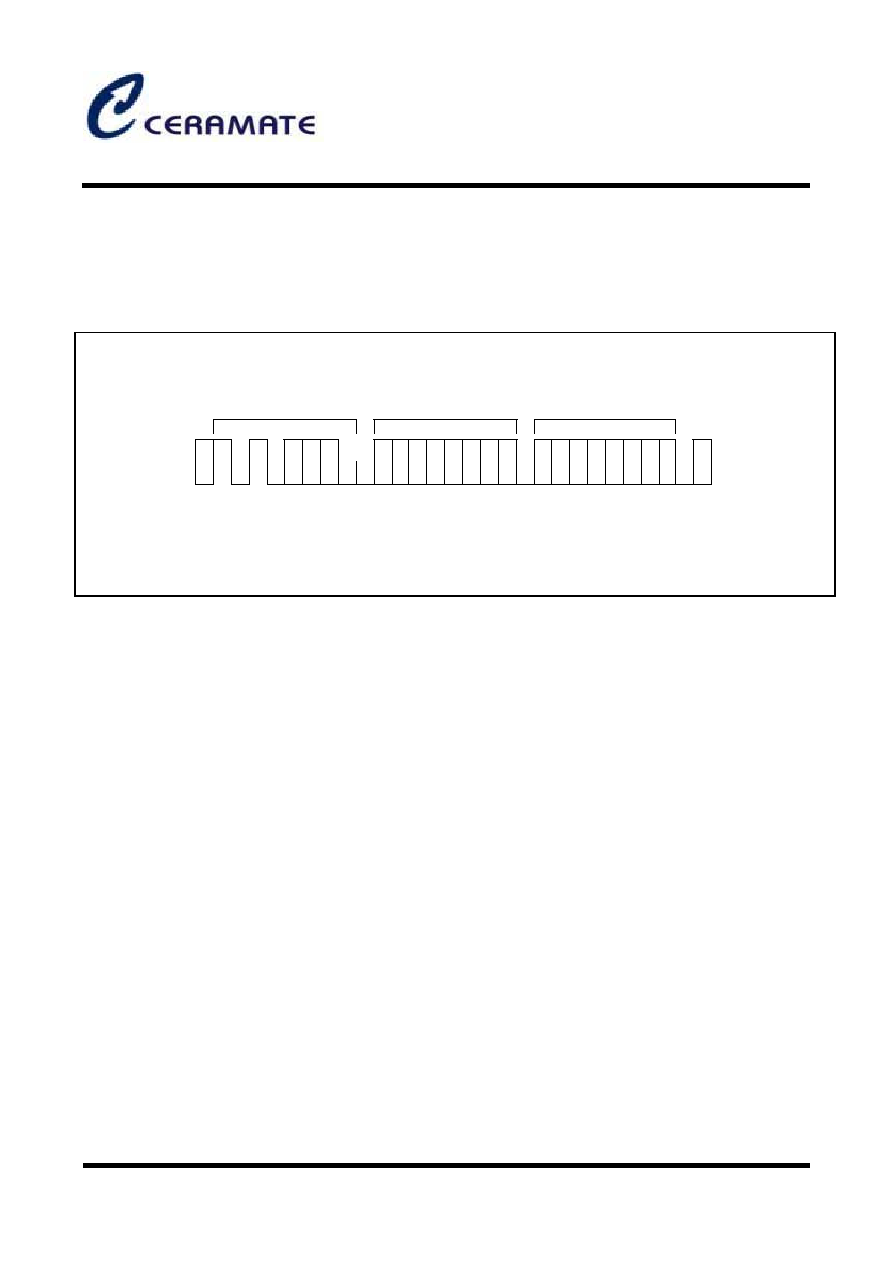
24LLC16
16K-Bit-Serial EEPROM
* All specs and applications shown above subject to change without prior notice.
1F-5 NO.66 SEC.2 NAN-KAN RD ., LUCHU , TAOYUAN, TAIWAN
Email: server@ceramate.com.tw
Tel:886-3-3214525 Http: www.ceramate.com.tw
Fax:886-3-3521052
Page
8 of 22
Rev 1.0 Aug.5, 2002
BYTE WRITE OPERATION
In a complete byte write operation, the master transmits the slave address, word address, and one data byte to
the 24LLC16 slave device (see Figure 5-9).
Slave Address Word Address
Start
A
C
K
A
C
K
Data
Stop
A
C
K
Figure 5-9. Byte Write Operation
Following a start condition, the master sends the device identifier (4 bits), three "don't care" bits, and an R
/
W
bit
set to "0" onto the bus. Then the addressed 24LLC16 generates an ACK, and waits for the next byte. The next
byte to be transmitted by the master is the word address. This 8-bit address is written into the word address
pointer of the 24LLC16
When the 24LLC16 receives the word address, it responds by issuing an ACK and then waits for the next 8-
bit data. When it receives the data byte, the 24LLC16 again responds with an ACK. The master terminates
the transfer by generating a Stop condition, at which time the 24LLC16 begins the internal write cycle.
While the internal write cycle is in progress, all 24LLC16 inputs are disabled and the 24LLC16 does not
respond to any additional request from the master.

24LLC16
16K-Bit-Serial EEPROM
* All specs and applications shown above subject to change without prior notice.
1F-5 NO.66 SEC.2 NAN-KAN RD ., LUCHU , TAOYUAN, TAIWAN
Email: server@ceramate.com.tw
Tel:886-3-3214525 Http: www.ceramate.com.tw
Fax:886-3-3521052
Page
9 of 22
Rev 1.0 Aug.5, 2002
PAGE WRITE OPERATION
The
24LLC16 can also perform 16-byte page write operation. A page write operation is initiated in the same
way as a byte write operation. However, instead of finishing the write operation after the first data byte is
transferred, the master can transmit up to 15 additional bytes. The
24LLC166 responds with an ACK each time
it receives a complete byte of data (see Figure 5-10).
Slave Address
Start
A
C
K
Word Address n
A
C
K
Data (<= n + 15)
Stop
A
C
K
A
C
K
...
Data n
A
C
K
Figure 5-10. Page Write Operation
The
24LLC16 automatically increments the word address pointer each time it receives a complete data byte.
When one byte is received, the internal word address pointer increments to the next address so that the next data
byte can be received.
If the master transmits more than 16 bytes before it generates a stop condition to end the page write operation,
the
24LLC16 word address pointer value "rolls over" and the previously received data is overwritten. If the
master transmits less than 16 bytes and generates a stop condition, the
24LLC16 writes the received data to
the corresponding EEPROM address.
During a page write operation, all inputs are disabled and there would be no response to additional requests from
the master until the internal write cycle is completed.

24LLC16
16K-Bit-Serial EEPROM
* All specs and applications shown above subject to change without prior notice.
1F-5 NO.66 SEC.2 NAN-KAN RD ., LUCHU , TAOYUAN, TAIWAN
Email: server@ceramate.com.tw
Tel:886-3-3214525 Http: www.ceramate.com.tw
Fax:886-3-3521052
Page
10 of 22
Rev 1.0 Aug.5, 2002
POLLING FOR AN ACK SIGNAL
When the master issues a stop condition to initiate a write cycle, the 24LLC16 starts an internal write cycle.
The master can then immediately begin polling for an ACK from the slave device to determine whether the write
cycle is completed.
To poll for an ACK signal in a write operation, the master issues a start condition followed by the slave address.
As long as the 24LLC16 remains busy with the write operation, no ACK is returned. When the 24LLC16
completes the write operation, it returns an ACK and the master can then proceed with the next read or write
operation (see Figure 5-11).
Send Write
Command
Send Stop Condition to
Initiate Write Cycle
Send Start
Condition
Send Slave Address
with R/
W
bit = "0"
Start Next
Operation
ACK = "0" ?
Yes
No
Figure 5-11. Master Polling for an ACK Signal from a Slave Device

24LLC16
16K-Bit-Serial EEPROM
* All specs and applications shown above subject to change without prior notice.
1F-5 NO.66 SEC.2 NAN-KAN RD ., LUCHU , TAOYUAN, TAIWAN
Email: server@ceramate.com.tw
Tel:886-3-3214525 Http: www.ceramate.com.tw
Fax:886-3-3521052
Page
11 of 22
Rev 1.0 Aug.5, 2002
HARDWARE-BASED WRITE PROTECTION
You can also write-protect the entire memory area of the 24LLC16 This method of write protection is
controlled by the state of the Write Protect (WP) pin.
When the WP pin is connected to V
CC
, any attempt to write a value to the memory is ignored.
The 24LLC16 will acknowledge slave and word address, but it will not generate an acknowledge after
receiving first byte of data. In this situation the write cycle will not be started when a stop condition is generated.
By connecting the WP pin to V
SS
, the write function is allowed for the entire memory.
These write protection features effectively change the EEPROM to a ROM in order to protect data from being
overwritten. Whenever the write function is disabled, a slave address and a word address are acknowledged on
the bus, but data bytes are not acknowledged.
The WP pin is internally pulled down to V
SS.
CURRENT ADDRESS BYTE READ OPERATION
The internal word address pointer maintains the address of the last word accessed, incremented by one.
Therefore, if the last access (either read or write) was to the address "n", the next read operation would access
data at address "n+1".
When the 24LLC16 receives a slave address with the R
/
W
bit set to "1", it issues an ACK and sends eight bits
of data. In a current address byte read operation the master does not acknowledge the data, and it generates a
Stop condition, forcing the 24LLC16 to stop the transmission (see Figure 5-12).
Slave Address Data
Start
A
C
K
N
O
A
C
K
Stop
Figure 5-12. Current Address Byte Read Operation
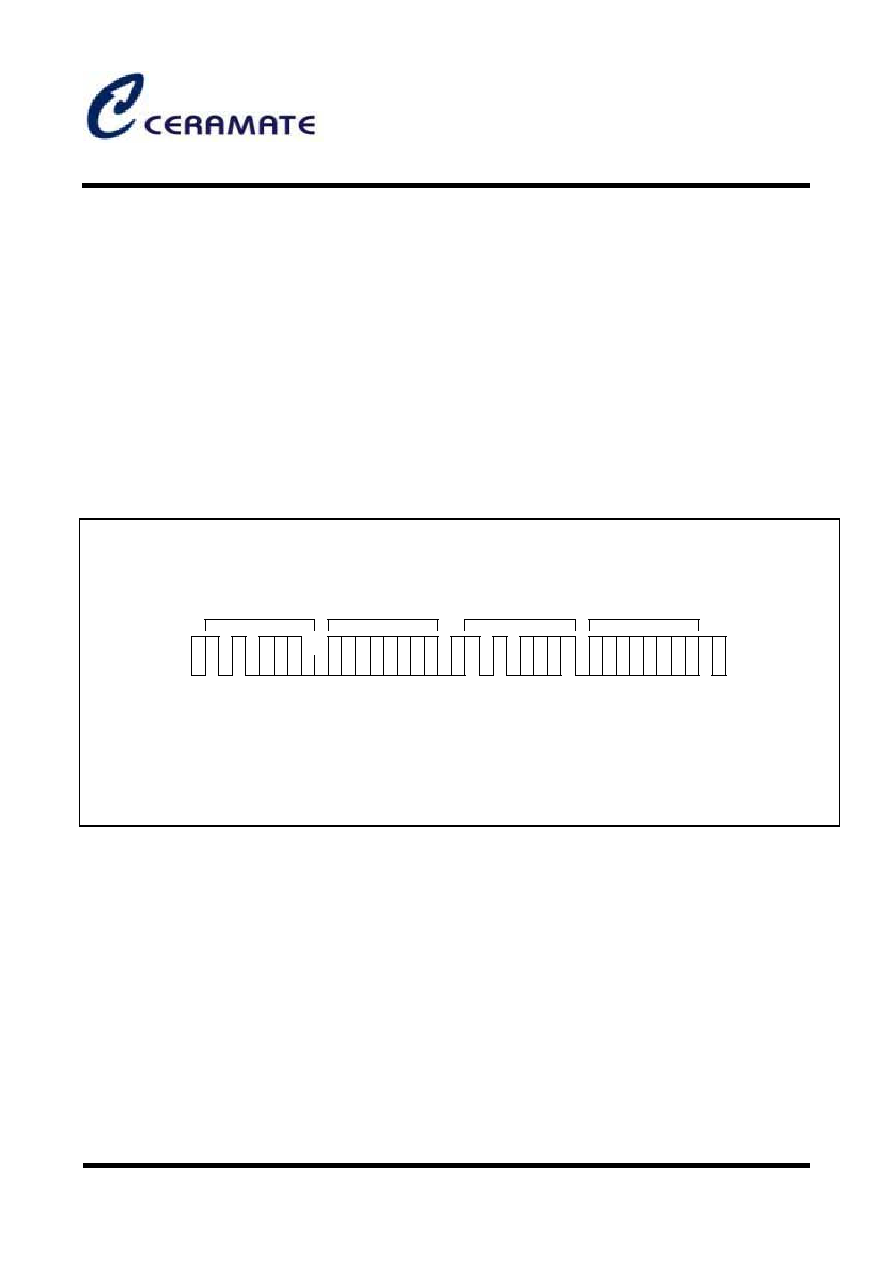
24LLC16
16K-Bit-Serial EEPROM
* All specs and applications shown above subject to change without prior notice.
1F-5 NO.66 SEC.2 NAN-KAN RD ., LUCHU , TAOYUAN, TAIWAN
Email: server@ceramate.com.tw
Tel:886-3-3214525 Http: www.ceramate.com.tw
Fax:886-3-3521052
Page
12 of 22
Rev 1.0 Aug.5, 2002
RANDOM ADDRESS BYTE READ OPERATION
Using random read operations, the master can access any memory location at any time. Before it issues the
slave address with the R
/
W
bit set to "1", the master must first perform a "dummy" write operation. This operation
is performed in the following steps:
1. The master first issues a start condition, the slave address, and the word address to be read. (This step sets
the internal word address pointer of the 24LLC16 to the desired address.)
2. When the master receives an ACK for the word address, it immediately re-issues a start condition followed
by another slave address, with the R
/
W
bit set to "1".
3. The 24LLC16 then sends an ACK and the 8-bit data stored at the pointed address.
4. At this point, the master does not acknowledge the transmission, generating a stop condition.
5. The 24LLC16 stops transmitting data and reverts to stand-by mode (see Figure 5-13).
Word
Address
Slave
Address
Start
A
C
K
A
C
K
A
C
K
Stop
Slave
Address
Start Data (n)
N
O
A
C
K
Figure 5-13. Random Address Byte Read Operation

24LLC16
16K-Bit-Serial EEPROM
* All specs and applications shown above subject to change without prior notice.
1F-5 NO.66 SEC.2 NAN-KAN RD ., LUCHU , TAOYUAN, TAIWAN
Email: server@ceramate.com.tw
Tel:886-3-3214525 Http: www.ceramate.com.tw
Fax:886-3-3521052
Page
13 of 22
Rev 1.0 Aug.5, 2002
SEQUENTIAL READ OPERATION
Sequential read operations can be performed in two ways: current address sequential read operation, and
random address sequential read operation. The first data is sent in either of the two ways, current address byte
read operation or random address byte read operation described earlier. If the master responds with an ACK, the
24LLC16
continues transmitting data. If the master does not issue an ACK, generating a stop condition, the
slave stops transmission, ending the sequential read operation.
Using this method, data is output sequentially from address "n" followed by address "n+1". The word address
pointer for read operations increments to all word addresses, allowing the entire EEPROM to be read sequentially
in a single operation. After the entire EEPROM is read, the word address pointer "rolls over" and the 24LLC16
continues to transmit data for each ACK it receives from the master (see Figure 5-14).
Slave Address
Data (n)
Start
A
C
K
N
O
A
C
K
Stop
Data (n+x)
A
C
K
A
C
K
~
~
Figure 5-14. Sequential Read Operation
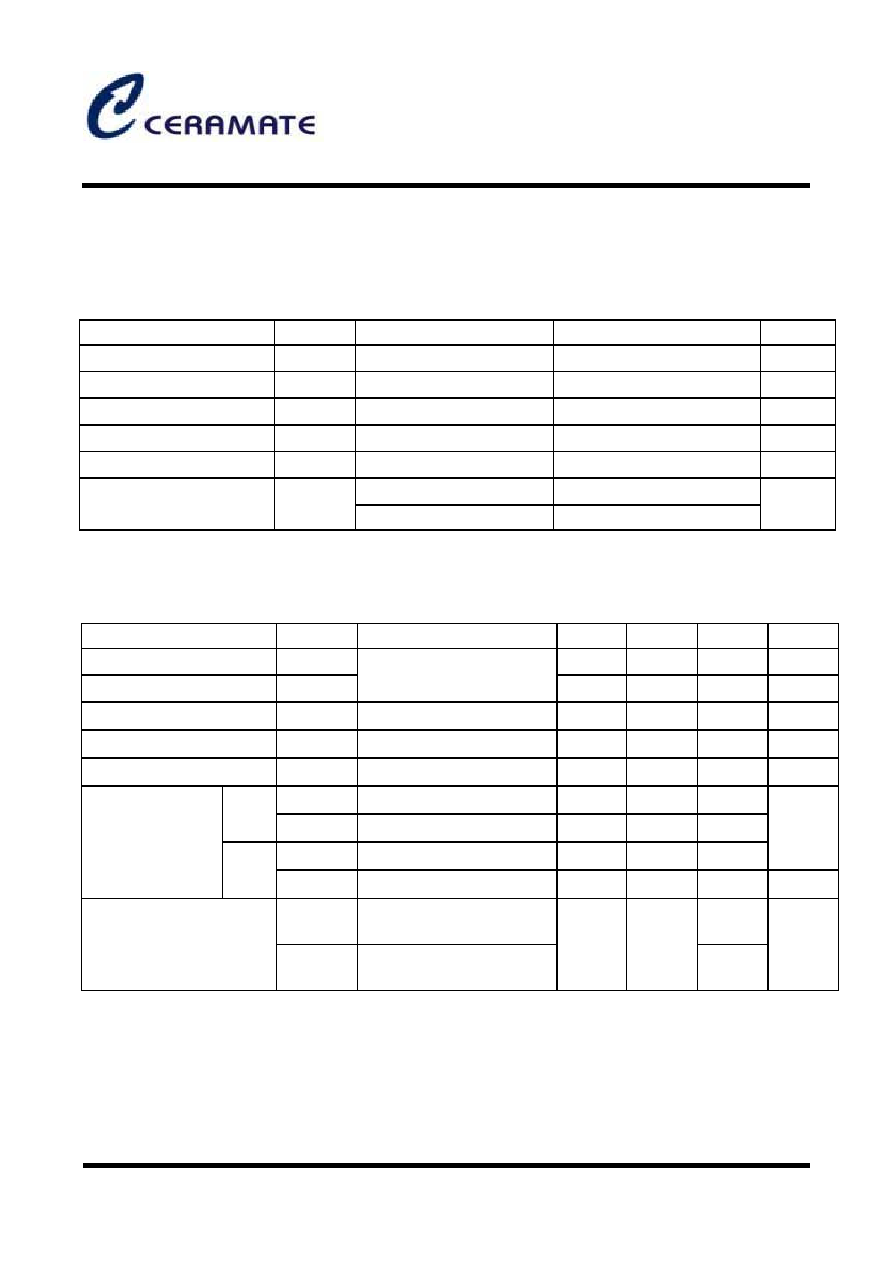
24LLC16
16K-Bit-Serial EEPROM
* All specs and applications shown above subject to change without prior notice.
1F-5 NO.66 SEC.2 NAN-KAN RD ., LUCHU , TAOYUAN, TAIWAN
Email: server@ceramate.com.tw
Tel:886-3-3214525 Http: www.ceramate.com.tw
Fax:886-3-3521052
Page
14 of 22
Rev 1.0 Aug.5, 2002
ELECTRICAL DATA
Table 5-3. Absolute Maximum Ratings
(T
A
= 25
�
C)
Parameter Symbol Conditions Rating Unit
Supply voltage V
CC
� � 0.3 to + 7.0 V
Input voltage V
IN
� � 0.3 to + 7.0 V
Output voltage V
O
� � 0.3 to + 7.0 V
Operating temperature T
A
� � 40 to + 85
�
C
Storage temperature T
STG
� � 65 to + 150
�
C
Electrostatic discharge V
ESD
HBM 5000 V
MM 400
Table 5-4. D.C. Electrical Characteristics
(T
A
= � 25
�
C to + 70
�
C (Commercial), � 40
�
C
to + 85
�
C (Industrial), V
CC
= 2.0 V to 5.5 V)
Parameter Symbol Conditions Min Typ Max Unit
Input low voltage V
IL
SCL, SDA � � 0.3 V
CC
V
Input high voltage V
IH
0.7 V
CC
� � V
Input leakage current I
LI
V
IN
= 0 to V
CC
� � 10 �A
Output leakage current I
LO
V
O
= 0 to V
CC
� � 10 �A
Output Low voltage V
OL
I
OL
= 3 mA, V
CC
= 2.0 V � � 0.4 V
Supply current Write I
CC1
V
CC
= 5.5 V, 400 kHz � � 3 mA
I
CC2
V
CC
= 2.0 V, 100 kHz � � 1
Read I
CC3
V
CC
= 5.5 V, 400 kHz � � 0.2
I
CC4
V
CC
= 2.0 V, 100 kHz � � 60 �A
Stand-by current I
CC5
V
CC
= SDA = SCL = 5.5 V,
all other inputs = 0 V
� � 5 �A
I
CC6
V
CC
= SDA = SCL = 2.0 V,
all other inputs = 0 V
� � 2

24LLC16
16K-Bit-Serial EEPROM
* All specs and applications shown above subject to change without prior notice.
1F-5 NO.66 SEC.2 NAN-KAN RD ., LUCHU , TAOYUAN, TAIWAN
Email: server@ceramate.com.tw
Tel:886-3-3214525 Http: www.ceramate.com.tw
Fax:886-3-3521052
Page
15 of 22
Rev 1.0 Aug.5, 2002
Table 5-4. D.C. Electrical Characteristics (Continued)
(T
A
= � 25
�
C to + 70
�
C (Commercial), � 40
�
C
to + 85
�
C (Industrial), V
CC
= 2.0 V to 5.5 V)
Parameter Symbol Conditions Min Typ Max Unit
Input capacitance C
IN
25
�
C, 1MHz,
V
CC
= 5 V, V
IN
= 0 V,
A0, A1, A2, SCL and WP pin
� � 10 pF
Input/Output capacitance C
I/O
25
�
C, 1MHz,
V
CC
= 5 V, V
I/O
= 0 V,
SDA pin
� � 10
Table 5-5. A.C. Electrical Characteristics
(T
A
= � 25
�
C to + 70
�
C (Commercial), � 40
�
C
to + 85
�
C (Industrial), V
CC
= 2.0 V to 5.5 V)
Parameter Symbol Conditions V
CC
= 2.0 to 5.5 V
(Standard Mode)
V
CC
= 4.5 to 5.5 V
(Fast Mode)
Unit
Min Max Min Max
External clock frequency F
clk
� 0 100
(1)
0 400
(1)
kHz
Clock High time t
HIGH
� 4 � 0.6 �
�
s
Clock Low time t
LOW
� 4.7 � 1.3 �
�
s
Rising time t
R
SDA, SCL � 1 � 0.3
�
s
Falling time t
F
SDA, SCL � 0.3 � 0.3
�
s
Start condition hold time t
HD:STA
� 4 � 0.6 �
�
s
Start condition setup time t
SU:STA
� 4.7 � 0.6 �
�
s
Data input hold time t
HD:DAT
� 0 � 0 �
�
s
Data input setup time t
SU:DAT
� 0.25 � 0.1 �
�
s
Stop condition setup time t
SU:STO
� 4 � 0.6 �
�
s
Bus free time t
BUF
Before new
transmission
4.7 � 1.3 �
�
s
Data output valid from
clock low
(2)
t
AA
� 0.3 3.5 � 0.9
�
s
Noise spike width t
SP
� � 100 � 50 ns
Write cycle time t
WR
� � 5 � 5 ms
NOTES
:
1. Upon customers request, up to 400 kHz (Max.) in standard mode and 1 MHz in fast mode are available.
2. When acting as a transmitter, the 24LLC16 must provide an internal minimum delay time to bridge the undefined
period (minimum 300 ns) of the falling edge of SCL. This is required to avoid unintended generation of a start or stop
condition.
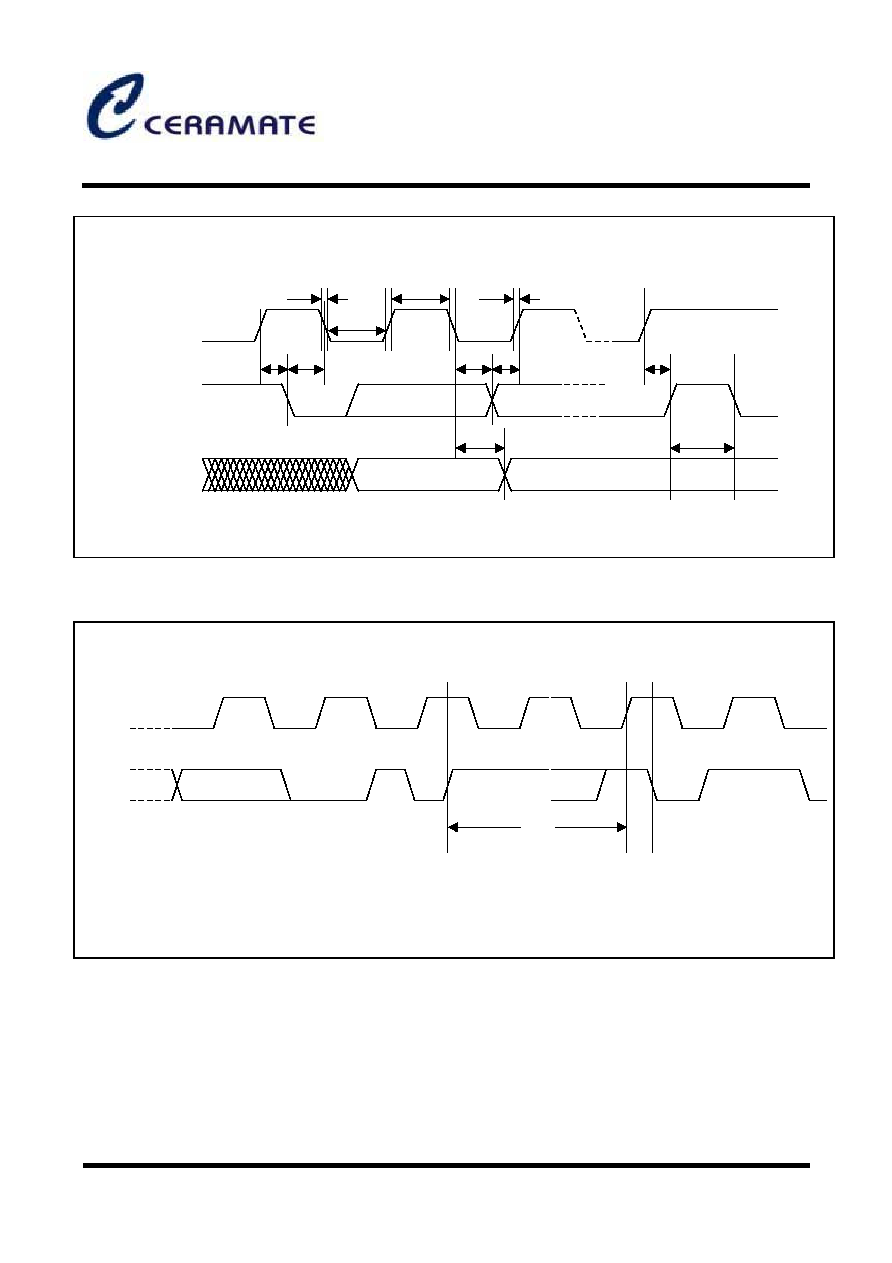
24LLC16
16K-Bit-Serial EEPROM
* All specs and applications shown above subject to change without prior notice.
1F-5 NO.66 SEC.2 NAN-KAN RD ., LUCHU , TAOYUAN, TAIWAN
Email: server@ceramate.com.tw
Tel:886-3-3214525 Http: www.ceramate.com.tw
Fax:886-3-3521052
Page
16 of 22
Rev 1.0 Aug.5, 2002
SCL
tLOW
tF
tR
SDA In
tSU:STA
tHD:STA
tHD:DAT
tSU:DAT
tSU:STO
tHIGH
SDA Out
tBUF
tAA
Figure 5-15. Timing Diagram for Bus Operations
8th Bit
WORDn
SCL
SDA
Start
Condition
~ ~
~~
~~
t
WR
Stop
Condition
ACK
Figure 5-16. Write Cycle Timing Diagram

24LLC16
16K-Bit-Serial EEPROM
* All specs and applications shown above subject to change without prior notice.
1F-5 NO.66 SEC.2 NAN-KAN RD ., LUCHU , TAOYUAN, TAIWAN
Email: server@ceramate.com.tw
Tel:886-3-3214525 Http: www.ceramate.com.tw
Fax:886-3-3521052
Page
17 of 22
Rev 1.0 Aug.5, 2002
CHARACTERISTIC CURVES
NOTE
The characteristic values shown in the following graphs are based on actual test measurements. They do
not, however, represent guaranteed operating values.
(Frequency = 100 kHz)
V
CC
(V)
I
CC
(mA)
0
0.4
0.8
1.2
1.6
2.0
1.5 2.5 3.5 4.5
5.5
Temp = -40
C
Temp = -25
C
Temp = 25
C
Temp = 70
C
Temp = 85
C
Figure 5-17. Write Current

24LLC16
16K-Bit-Serial EEPROM
* All specs and applications shown above subject to change without prior notice.
1F-5 NO.66 SEC.2 NAN-KAN RD ., LUCHU , TAOYUAN, TAIWAN
Email: server@ceramate.com.tw
Tel:886-3-3214525 Http: www.ceramate.com.tw
Fax:886-3-3521052
Page
18 of 22
Rev 1.0 Aug.5, 2002
(Frequency = 100 kHz)
V
CC
(V)
I
CC
(uA)
0
40
80
100
120
140
1.5 2.5 3.5 4.5 5.5
Temp = -40
C
Temp = -25
C
Temp = 25
C
Temp = 70
C
Temp = 85
C
60
20
Figure 5-18. Read Current
V
CC
(V)
I
CC
(uA)
0
0.3
0.6
0.9
1.2
1.5
1.5 2.5 3.5 4.5 5.5
Temp = -40
C
Temp = -25
C
Temp = 25
C
Temp = 70
C
Temp = 85
C
Figure 5-19. Stand-by Current
(Frequency = 100 kHz)

24LLC16
16K-Bit-Serial EEPROM
* All specs and applications shown above subject to change without prior notice.
1F-5 NO.66 SEC.2 NAN-KAN RD ., LUCHU , TAOYUAN, TAIWAN
Email: server@ceramate.com.tw
Tel:886-3-3214525 Http: www.ceramate.com.tw
Fax:886-3-3521052
Page
19 of 22
Rev 1.0 Aug.5, 2002
I
OL
(mA)
V
OL
(V)
(T
A
= 25 C)
1 2 3 4 6
0 5
V
DD
= 2 V
V
DD
= 3 V
V
DD
= 4 V
V
DD
= 5 V
V
DD
= 6 V
0
10
20
30
40
70
50
60
Figure 5-20. Output Low Voltage

24LLC16
16K-Bit-Serial EEPROM
* All specs and applications shown above subject to change without prior notice.
1F-5 NO.66 SEC.2 NAN-KAN RD ., LUCHU , TAOYUAN, TAIWAN
Email: server@ceramate.com.tw
Tel:886-3-3214525 Http: www.ceramate.com.tw
Fax:886-3-3521052
Page
20 of 22
Rev 1.0 Aug.5, 2002
Package Information
7
15 (4X)
(4X)
E1
D
PIN #1 INDENT O0.025 DEEP 0.006-0.008
E-PIN O0.118 NOTE 9
A
L
A2
A1
B2
B1
B
e
S
E
C
eB
DIMENSIONS IN MILLIMETERS DIMENSIONS IN INCHS
SYMBOL
MIN NOM MAX MIN NOM MAX
A
- - 5.33 - - 0.210
A1
0.38 - - 0.015 - -
A2
3.25 3.30 3.45 0.128 0.130 0.136
B
0.36 0.46 0.56 0.014 0.018 0.022
B1
1.14 1.27 1.52 0.045 0.050 0.060
B2
0.81 0.99 1.17 0.032 0.039 0.046
C
0.20 0.25 0.33 0.008 0.010 0.013
D
9.12 9.30 9.53 0.359 0.366 0.375
E
7.62 - 8.26 0.300 - 0.325
E1
6.20 6.35 6.60 0.244 0.250 0.260
e
-
2.54
-
-
0.100
-
L
3.18
-
-
0.125
-
-
Eb
8.38
-
9.40
0.330
-
0.370
s
0.71 0.84 0.97 0.028 0.033 0.038
(1) PDIP-8L

24LLC16
16K-Bit-Serial EEPROM
* All specs and applications shown above subject to change without prior notice.
1F-5 NO.66 SEC.2 NAN-KAN RD ., LUCHU , TAOYUAN, TAIWAN
Email: server@ceramate.com.tw
Tel:886-3-3214525 Http: www.ceramate.com.tw
Fax:886-3-3521052
Page
21 of 22
Rev 1.0 Aug.5, 2002
A
0.015x45
VIEW "A"
L
H
E
A2
A1
B
e
y
7 (4X)
D
C
7 (4X)
VIEW "A"
DIMENSIONS IN MILLIMETERS DIMENSIONS IN INCHS
SYMBOL
MIN NOM MAX MIN NOM MAX
A
1.47 1.60 1.73 0.058 0.063 0.068
A1
0.10 - 0.25 0.004 - 0.010
A2
- 1.45 - - 0.057 -
B
0.33 0.41 0.51 0.013 0.016 0.020
C
0.19 0.20 0.25 0.0075 0.008 0.0098
D
4.80 4.85 4.95 0.189 0.191 0.195
E
3.81 3.91 3.99 0.150 0.154 0.157
e
- 1.27 - - 0.050 -
H
5.79 5.99 6.20 0.228 0.236 0.244
L
0.38 0.71 1.27 0.015 0.028 0.050
Y
- - 0.10 - - 0.004
0
o
- 8
o
0
o
- 8
o
(2) SOP-8L(JEDEC)

24LLC16
16K-Bit-Serial EEPROM
* All specs and applications shown above subject to change without prior notice.
1F-5 NO.66 SEC.2 NAN-KAN RD ., LUCHU , TAOYUAN, TAIWAN
Email: server@ceramate.com.tw
Tel:886-3-3214525 Http: www.ceramate.com.tw
Fax:886-3-3521052
Page
22 of 22
Rev 1.0 Aug.5, 2002
(3) TSSOP-8L
A
E
E1
b
y
e
C
DETAIL A
DETAIL A
L 1
L
E1 L1
A2
A1
D
PIN 1 INDICATOR O0.70
SURFACE POLISHED
DIMENSIONS IN MILLIMETERS
SYMBOLS
MIN NOM MAX
A 1.05 1.10 1.20
A1 0.05 0.10 0.15
A2 - 1.00 1.05
B 0.20 0.25 0.28
C - 0.127 -
D 2.90 3.05 3.10
E 6.20 6.40 6.60
E1 4.30 4.40 4.50
E - 0.65 -
L 0.50 0.60 0.70
L1 0.90 1.00 1.10
Y
- - 0.10
0
o
4
o
8
o





















